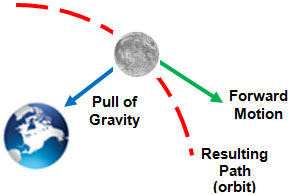Much of what we know about planetary orbits and gravity can be traced back to two scientists, Johannes Kepler and Isaac Newton.
Johannes Kepler was a German mathematician and worked as an assistant to a Danish astronomer named Tycho Brache who had observed the positions of the planets for over a quarter of a century. When Brache died in 1601, Kepler inherited all of his records. Kepler’s goal was to understand the motions of the planets. He described three laws of planetary motion.
Kepler discovered that the planet Mars did not move around the sun in a regular circle, but in an elongated circle called an ellipse.
![]() Extension Activites
Extension Activites
Kepler discovered that planets seem to move faster when they are closer to the sun, and this is Kepler’s second law of planetary motion.
Kepler’s third law of planetary motion compares the period of a planet’s revolution with its semi-major axis. By doing some mathematical calculations, Kepler was able to show that by knowing a planet’s period of revolution, the planet’s distance from the sun can be calculated.

Source:
Isaac Newton, 1689,
Godfrey Kneller, Wikimedia
Kepler wondered what caused the planets closest to the sun to move faster than the planets farther away, but he never discovered the answer. It was Sir Isaac Newton who finally answered that question. You learned about some of Newton’s work in module 2 of this course. Sir Isaac Newton was an English physicist, mathematician, and astronomer.
Newton did not understand why gravity worked or what caused it. Even today's scientists do not fully understand gravity. By combining the works of early scientists, Newton was able to explain how the force of attraction between matter works.
Newton hypothesized that small objects fall toward larger objects because they are attracted to each other by the force of gravity. For example, the planets fall toward the sun, but because the sun has so much more mass than the smaller planets only the planets appear to move.
Newton developed his law of universal gravitation which states that the force of gravity depends on the product of the masses of the objects divided by the square of the distances between them. You saw a simple model of how the masses of objects and their distances affect the strength of gravity and the orbit of the planets in sections 1 and 2 of this lesson. (You will learn more about this and how to calculate the strength of gravitational attraction between two objects when you take Physics in high school.)
Newton did not close the book on gravity. Albert Einstein continued to study gravity, and his findings led to the development of his Theory of Relativity. You will learn more about this when you take high school physics.

Source: ClipartPal and PSD Graphics
We know according to Newton’s first law of motion that an object in motion tends to stay in motion unless acted upon by an outside force. (This law of motion was reviewed in Module 2 Lesson 8.) This law means that any object, unless acted upon by an outside force, will travel in a straight line. This is what happens with the planets; they would move in a straight line but are acted upon by gravity.
The reason the Earth moves in an elliptical orbit is a combination of the Earth's tendency to follow a straight path as it speeds through space and sun's gravitational pull. The Earth moves at a rate of 68,400 miles an hour! The diagram above shows this.

Source: NASA and PSD Graphics
Does Earth orbit the moon or vice versa? The moon orbits the Earth. The Earth has a larger mass; therefore, it has a stronger gravity. So the moon orbits Earth.
All the principles of gravity that we learned in the previous sections of this lesson apply to the Earth and the moon. The moon completes its orbit around the Earth about every 28 days. You will learn more about the moon's orbit around the Earth in lesson 3 of this module. This diagram shows why the moon orbits the Earth.